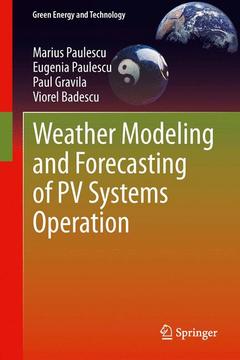Description
Weather Modeling and Forecasting of PV Systems Operation, 2013
Green Energy and Technology Series
Authors: Paulescu Marius, Paulescu Eugenia, Gravila Paul, Badescu Viorel
Language: English
Subjects for Weather Modeling and Forecasting of PV Systems Operation:
158.24 €
In Print (Delivery period: 15 days).
Add to cartPublication date: 12-2014
358 p. · 15.5x23.5 cm · Paperback
158.24 €
In Print (Delivery period: 15 days).
Add to cartPublication date: 11-2012
358 p. · 15.5x23.5 cm
Description
/li>Contents
/li>Biography
/li>Comment
/li>
In the past decade, there has been a substantial increase of grid-feeding photovoltaic applications, thus raising the importance of solar electricity in the energy mix. This trend is expected to continue and may even increase. Apart from the high initial investment cost, the fluctuating nature of the solar resource raises particular insertion problems in electrical networks. Proper grid managing demands short- and long-time forecasting of solar power plant output.
Weather modeling and forecasting of PV systems operation is focused on this issue. Models for predicting the state of the sky, nowcasting solar irradiance and forecasting solar irradiation are studied and exemplified. Statistical as well as artificial intelligence methods are described. The efficiency of photovoltaic converters is assessed for any weather conditions.
Weather modeling and forecasting of PV systems operation is written for researchers, engineers, physicists and students interested in PV systems design and utilization.
<
Dr. Marius Paulescu is an Associate Professor at the Physics Department of the West University of Timisoara (Romania). Since 2000 he has been active in the field of solar energy conversion, covering the whole range from solar radiation modeling and measurements to quantum physics applied to photovoltaic devices. His main scientific contributions are related to solar radiation estimation using statistical and fuzzy algorithms, state of the sky description and forecasting, development of solar radiation models based on air temperature data and modeling quantum solar cells.
Dr. Eugenia Tulcan-Paulescu graduated in physics and mathematics from the West University of Timisoara (Romania), and earned a PhD in applied mathematics at the same university. Since 2005 she has been a lecturer at the Physics Department and was the person in charge of the Solar Platform project, including designing and building of the first Romanian station outfitted for systematic monitoring of solar irradiance on tilted surfaces, which has been in operation since 2008.
Dr. Paul Gravila holds a PhD in Physics from the University of Zurich and is active at the Physics Department of the West University of Timisoara (Romania) in theoretical and computational physics. He covers a broad range from ab-initio methods in quantum solid state physics to elementary particle physics, is fluent with computer programming, numerical methods and symbolic calculus. Since 2008 he has worked in collaboration with the other authors of this book in the field of solar energy.
Professor Viorel Badescu is a scientist presently affiliated with Candida Oancea Institute at Polytechnic University of Bucharest. His mainstream scientific contribution consists of more than 200 papers and 30 books related to statistical physics and thermodynamics, the physics of semiconductors, and various aspects of terrestrial and space solar energy applications. In addition, he has theorized on prese




